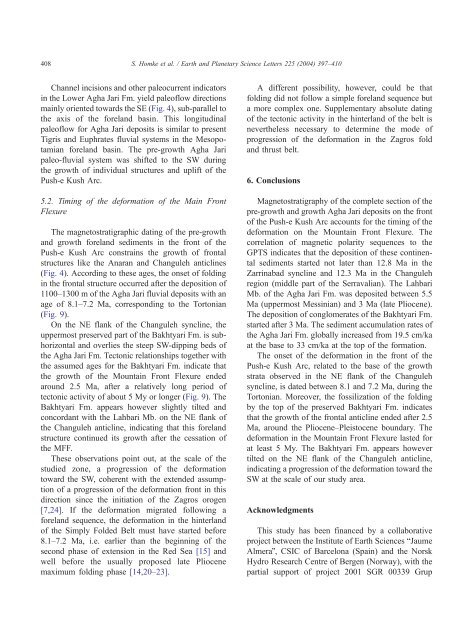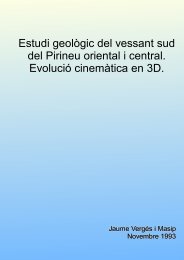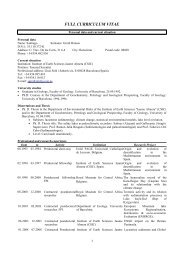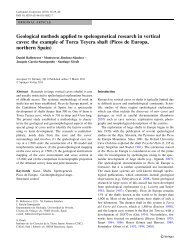Magnetostratigraphy of Miocene–Pliocene Zagros foreland deposits ...
Magnetostratigraphy of Miocene–Pliocene Zagros foreland deposits ...
Magnetostratigraphy of Miocene–Pliocene Zagros foreland deposits ...
You also want an ePaper? Increase the reach of your titles
YUMPU automatically turns print PDFs into web optimized ePapers that Google loves.
408<br />
S. Homke et al. / Earth and Planetary Science Letters 225 (2004) 397–410<br />
Channel incisions and other paleocurrent indicators<br />
in the Lower Agha Jari Fm. yield pale<strong>of</strong>low directions<br />
mainly oriented towards the SE (Fig. 4), sub-parallel to<br />
the axis <strong>of</strong> the <strong>foreland</strong> basin. This longitudinal<br />
pale<strong>of</strong>low for Agha Jari <strong>deposits</strong> is similar to present<br />
Tigris and Euphrates fluvial systems in the Mesopotamian<br />
<strong>foreland</strong> basin. The pre-growth Agha Jari<br />
paleo-fluvial system was shifted to the SW during<br />
the growth <strong>of</strong> individual structures and uplift <strong>of</strong> the<br />
Push-e Kush Arc.<br />
5.2. Timing <strong>of</strong> the deformation <strong>of</strong> the Main Front<br />
Flexure<br />
The magnetostratigraphic dating <strong>of</strong> the pre-growth<br />
and growth <strong>foreland</strong> sediments in the front <strong>of</strong> the<br />
Push-e Kush Arc constrains the growth <strong>of</strong> frontal<br />
structures like the Anaran and Changuleh anticlines<br />
(Fig. 4). According to these ages, the onset <strong>of</strong> folding<br />
in the frontal structure occurred after the deposition <strong>of</strong><br />
1100–1300 m <strong>of</strong> the Agha Jari fluvial <strong>deposits</strong> with an<br />
age <strong>of</strong> 8.1–7.2 Ma, corresponding to the Tortonian<br />
(Fig. 9).<br />
On the NE flank <strong>of</strong> the Changuleh syncline, the<br />
uppermost preserved part <strong>of</strong> the Bakhtyari Fm. is subhorizontal<br />
and overlies the steep SW-dipping beds <strong>of</strong><br />
the Agha Jari Fm. Tectonic relationships together with<br />
the assumed ages for the Bakhtyari Fm. indicate that<br />
the growth <strong>of</strong> the Mountain Front Flexure ended<br />
around 2.5 Ma, after a relatively long period <strong>of</strong><br />
tectonic activity <strong>of</strong> about 5 My or longer (Fig. 9). The<br />
Bakhtyari Fm. appears however slightly tilted and<br />
concordant with the Lahbari Mb. on the NE flank <strong>of</strong><br />
the Changuleh anticline, indicating that this <strong>foreland</strong><br />
structure continued its growth after the cessation <strong>of</strong><br />
the MFF.<br />
These observations point out, at the scale <strong>of</strong> the<br />
studied zone, a progression <strong>of</strong> the deformation<br />
toward the SW, coherent with the extended assumption<br />
<strong>of</strong> a progression <strong>of</strong> the deformation front in this<br />
direction since the initiation <strong>of</strong> the <strong>Zagros</strong> orogen<br />
[7,24]. If the deformation migrated following a<br />
<strong>foreland</strong> sequence, the deformation in the hinterland<br />
<strong>of</strong> the Simply Folded Belt must have started before<br />
8.1–7.2 Ma, i.e. earlier than the beginning <strong>of</strong> the<br />
second phase <strong>of</strong> extension in the Red Sea [15] and<br />
well before the usually proposed late Pliocene<br />
maximum folding phase [14,20–23].<br />
A different possibility, however, could be that<br />
folding did not follow a simple <strong>foreland</strong> sequence but<br />
a more complex one. Supplementary absolute dating<br />
<strong>of</strong> the tectonic activity in the hinterland <strong>of</strong> the belt is<br />
nevertheless necessary to determine the mode <strong>of</strong><br />
progression <strong>of</strong> the deformation in the <strong>Zagros</strong> fold<br />
and thrust belt.<br />
6. Conclusions<br />
<strong>Magnetostratigraphy</strong> <strong>of</strong> the complete section <strong>of</strong> the<br />
pre-growth and growth Agha Jari <strong>deposits</strong> on the front<br />
<strong>of</strong> the Push-e Kush Arc accounts for the timing <strong>of</strong> the<br />
deformation on the Mountain Front Flexure. The<br />
correlation <strong>of</strong> magnetic polarity sequences to the<br />
GPTS indicates that the deposition <strong>of</strong> these continental<br />
sediments started not later than 12.8 Ma in the<br />
Zarrinabad syncline and 12.3 Ma in the Changuleh<br />
region (middle part <strong>of</strong> the Serravalian). The Lahbari<br />
Mb. <strong>of</strong> the Agha Jari Fm. was deposited between 5.5<br />
Ma (uppermost Messinian) and 3 Ma (late Pliocene).<br />
The deposition <strong>of</strong> conglomerates <strong>of</strong> the Bakhtyari Fm.<br />
started after 3 Ma. The sediment accumulation rates <strong>of</strong><br />
the Agha Jari Fm. globally increased from 19.5 cm/ka<br />
at the base to 33 cm/ka at the top <strong>of</strong> the formation.<br />
The onset <strong>of</strong> the deformation in the front <strong>of</strong> the<br />
Push-e Kush Arc, related to the base <strong>of</strong> the growth<br />
strata observed in the NE flank <strong>of</strong> the Changuleh<br />
syncline, is dated between 8.1 and 7.2 Ma, during the<br />
Tortonian. Moreover, the fossilization <strong>of</strong> the folding<br />
by the top <strong>of</strong> the preserved Bakhtyari Fm. indicates<br />
that the growth <strong>of</strong> the frontal anticline ended after 2.5<br />
Ma, around the Pliocene–Pleistocene boundary. The<br />
deformation in the Mountain Front Flexure lasted for<br />
at least 5 My. The Bakhtyari Fm. appears however<br />
tilted on the NE flank <strong>of</strong> the Changuleh anticline,<br />
indicating a progression <strong>of</strong> the deformation toward the<br />
SW at the scale <strong>of</strong> our study area.<br />
Acknowledgments<br />
This study has been financed by a collaborative<br />
project between the Institute <strong>of</strong> Earth Sciences bJaume<br />
AlmeraQ, CSIC <strong>of</strong> Barcelona (Spain) and the Norsk<br />
Hydro Research Centre <strong>of</strong> Bergen (Norway), with the<br />
partial support <strong>of</strong> project 2001 SGR 00339 Grup





